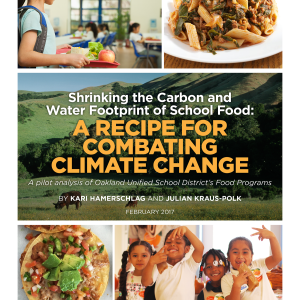
Based on a case study from Oakland California, a new report by Friends of the Earth US finds that schools can make lunches healthier and more climate-friendly while also saving money— by reformulating menus so that they are more plant centred, and contain less (and better) meat and fewer dairy products.
Abstract
As schools across the nation grapple with how to feed kids healthier, more sustainable food on tight budgets, an inspiring story from Oakland Unified School District provides a roadmap for change. Friends of the Earth’s new case study shows how the district was able to significantly reduce its carbon and water footprint by replacing a share of its meat, poultry and cheese purchases with plant-based proteins. These actions also saved the district money and improved students’ access to healthful food.
Despite the growing trend towards serving more plant-based meals, shifting institutional food purchasing towards less and better meat has rarely been tapped as a climate mitigation strategy. We hope this report inspires more public institutions to track their animal foods purchases and serve less and better meat and more plant-based foods as a cost-effective way to achieve environmental and public health goals. We also hope policymakers will begin to consider meat reduction as a powerful, cost-effective climate mitigation strategy.
If institutions across the country made similar menu shifts to Oakland Unified School District, we could achieve dramatic reductions in carbon emissions and water use with no additional cost to schools. This is a rare silver bullet solution that can address many challenges simultaneously!
Reference
Friends of the Earth U.S., Shrinking the Carbon and Water Footprint of School Food: A Recipe for Combatting Climate Change, Washington DC | Berkeley CA
Read the full report here and see an article about the research on the Green School’s National Network website. You can also read the press release and see a blog on EcoCentric by Friends of the Earth.







Post a new comment »